For Animal Management Animal Nutrition Unit 319 Task A - Components of an animal's diet
Pinned to
408
2
0
No tags specified
|
|
Created by maisey moo
about 10 years ago
|
|
Close
|
|
Created by maisey moo
about 10 years ago
|
|

Animal Nutrition
Task A
Components of an animal's diet
Carbohydrates
Why are Carbohydrates needed?
Carbohydrates are needed in the body as they provide energy. The energy is needed for movement.
Fats
Why are fats needed?
Fats are needed in the body to help to provide insulation. They help to
keep the animals warm. Also fats are stored as a second source of
energy.
Vitamins
Why are vitamins needed?
1. Vitamin A helps with body growth, and cell division.
2.. Vitamin B helps to reduce the risk of stress.
3. Vitamin C helps to promote healing
4. Vitamin D helps to reduce the risk of getting a bone disease. This disease is known as rickets.
5. Vitamin E is used to keep skin and fur healthy.
6. Vitamin K is needed as it known to help with reproductions.
Macro minerals
What are Macro minerals?
Macro minerals are found in larger levels of minerals.
Sulphur
Where is it found?
Sulphur is found in nuts, amino acids and proteins (meat).
Functions
Sulphur aids in enzyme reactions and the process of protein synthesis. Sulphur is used in the formation of Collagen which forms the connective tissue. Sulphur is present in Keratin which maintains skin, hair and nails which gives strength, shape and hardness to the proteins tissues.
Sodium
Where is Sodium found?
Sodium is found in blood, eggs, meat, fish and salt.
Functions
Sodium prevents cells from swelling and becoming dehydrated. Sodium helps maintain the cellular environment. Sodium also maintains the correct working order of nerve and muscle cell function.
Calcium
Where is Calcium found?
Calcium is found in milk and other diary products.
Functions
Calcium is used to maintain general body health and to build strong bones and teeth. calcium is also used for muscle function and vascular contraction.
Chloride
Where is Chloride found?
Chloride is found in salts and vegetables.
Functions
Chloride generates the osmotic pressure of the body fluids. Chloride is an important component of stomach hydrochloric acid which is the key to the digestive acid.
Micro minerals include:
1. Copper
2. Iodine
3. Magnesium
4. Iron
5. Zinc
6. Manganese
7. Cobalt
Iodine
Where is Iodine found?
Iodine can be found in species that live in the water. Fish, shellfish and sea vegetables (seaweed).
Functions
Iodine is used in the production of the Thyroid hormones, and regulates thyroid function.
Iron
Where is Iron found?
Iron is found in cereals and breads.
Functions
Iron is a component of various enzyme systems. Iron is used in the formation of haemoglobin and myoglobin.
Manganese
Where is Manganese found?
Manganese can be found in nuts and whole grain foods.
Functions
Manganese is used in enzyme activation. Manganese is a catalyst for many biochemical reactions in the body.
Metabolism
What is metabolism?
Metabolism is the process in which the body makes energy.
Metabolic Pathways
Metabolic pathways are the ways in which the body creates energy that can be used by cells. This happens by breaking down glucose.
Each stage of the metabolic process releases energy that carry molecules.
1. ATP (Adenosine Triphosphate)
2. FADH2 (Flavin Adenine Dinucleotic)
The Krebs Cycle
This is the second stage of metabolism. The Pyruvate that was produced during the first stage is then converted in acetyl CoA.
The krebs cycle then converts the acetyl CoA into:
1. Carbon Dioxide
2. Two molecules of NADH
3. Two molecules of FADH2.
This process generally occurs in the mitochondria.
Digestive System of a Dog
Dog are single stomached animals.
This means that there is only one stomach and one compartment.
Metabolising & Digesting Carbohydrates in Dogs (single stomached)
Carbohydrates begin to metabolise in the small intestines where monosaccharides are absorbed into the blood stream. Blood sugar concentrations are controlled by three hormones: insulin, glucagon, and epinephrine. If the concentration of glucose in the blood is too high, insulin is released by the pancreas.
The insulin stimulates the transfer of glucose into the cells, especially in the liver and muscles, although other organs are also capable of metabolising glucose.
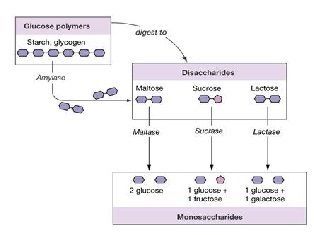
Metabolising & Digesting Proteins in Dogs (single stomached)
Once you have chewed and swallowed your food, the low pH of the stomach acid begins to unfold the proteins that are consumed. The unfolding of the proteins is important as it allows the digestive enzymes to access the bonds that are holding the individual amino acids together.
The gastric juice in the stomach contains a protease, or protein degrading enzyme, called pepsin. Pepsin cleaves the large and unfolded protein molecule into smaller pieces of protein known as peptides.
The micro-organisms you may inadvertently consume with your food usually die in the presence of your stomach acid. The proteins they contain join the pool of food proteins in the digestive process.
Metabolising & Digesting Fats in Dogs (single stomached)
The metabolism of fats begins when a gland under the tongue releases the fat-splitting enzyme lingual lipase. Gastric lipase, which is released by cells in the stomach, continues to work on the fat molecules as the muscles of the stomach wall act like a blender mixing the contents of the stomach.
Metabolising & Digesting Water in Dogs (single stomached)
Water is absorbed almost immediately after consumption. The journey starts in the digestive tract in the mouth.
Water that is consumed alone moves through the system more quickly than solid food. The water that is drunk during and after feed times mixes with the feed and helps the body digest it more efficiently by breaking it down.
Metabolising & Digesting Vitamins and Minerals in Dogs (single stomached)
Vitamins and minerals are broken down, digested and absorbed similarly in the body. There are a variety of vitamins and minerals that are needed in the diet to support each and every function. Vitamins are organic compounds which are made by plants, animals and humans.
Minerals are inorganic elements, occurring naturally in soil and water. Plants absorb minerals through their roots and you absorb the minerals when you eat the plant food. Animals also eat plants. This means that you can also get some minerals indirectly by consuming foods which originate from animal sources.
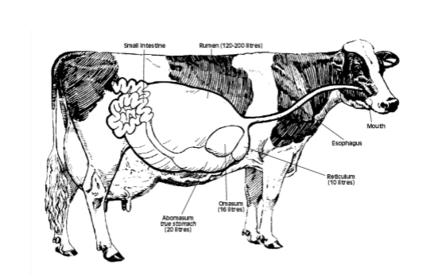
Ruminant Animals continued
Ruminant animals need four compartments to cope with the digestion of grass and vegetation
Ruminant animals do not completely chew the grass or vegetation that they consume. The partially chewed grass/vegetation goes into the large rumen where it is stored and broken down into balls of “cud”. When the animal has eaten, it will rest and “chew its cud”.
The cud is then swallowed once again. This pass into the next three compartments: the reticulum, the omasum and the abomasum.
Rumen continued
When food is in the rumen, the bacteria digests the fibre. This turns the fibre into fatty acids, proteins and Vitamin B's. The rumen has a good blood supply, the nutrients are easily absorbed by the body for.
After this part of the digestive process, the "digesta," as the food is termed, heads to the reticulum for the next phase of digestion..
Omasum
The omasum is the third compartment of the stomach. The omasum us pathway to the abomasum. It filters large particles and send them back tot the reticulorumen. It also enables fine particles and fluid to be passed to the abomasum.
Abomasum
This is the fourth compartment of the stomach. The abomasum is also known as the “true stomach.” The abomasum just like a human stomach produces acid and some enzymes to start the digestion of proteins.
Animals that go off feed can develop a displaced abomasum. The abomasum will float out of place and become twisted. This stops the flow of digestion. A displaced abomasum can happen in cattle that have severe digestive problems.
Surgery is the only cure for a
displaced abomasum.
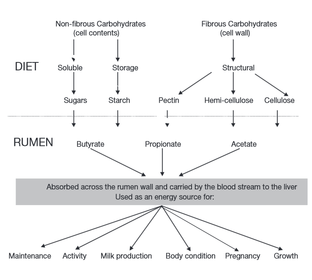
Metabolising & Digesting Carbohydrates
in Cows (ruminant)
Rumen microbes break down all carbohydrates. However the soluble and storage forms are broken down more quickly than the structural forms.
Sugars and starches are broken down
easily and quickly. As plants mature their cell walls become more rigid. The lignin reduces the availability and utilisation of structural carbohydrates. As plants mature,
their digestibility decreases because the components of their cell walls become less accessible and more difficult to digest.
Soluble carbohydrates are digested 100 times faster by the microbes in the rumen than storage carbohydrates are. While storage carbohydrates are digested about five times faster than structural carbohydrates.
Structural Carbohydrates
Reduction or loss of these bacteria not only reduces the digestibility of the feed, but it may also reduce the cow’s intake of feed.
Once structural carbohydrates have passed through the rumen, there is little
chance that they will be broken down any further.
Soluble Sugars
The bacteria that breaks down the feeds high in soluble sugars are similar to the bacteria that break down starch.
Sugary feeds generally cause less
problems with increased acidity in the rumen than starchy feeds. However, sugary feeds need to be introduced to a cow’s diet slowly.
Metabolising & Digesting Proteins in Cows (ruminant)
Feed proteins are broken down by micro-organisms in the rumen through amino acids into ammonia and fatty acid chains.
Non-protein nitrogen from the feed and the urea are recycled into the rumen through the saliva. The rumen wall contributes also to the pool of ammonia in the rumen. If ammonia levels in the rumen are too low there will be a nitrogen shortage. The bacteria and the feed will decrease in the performance of digestion.
Too much ammonia in the rumen leads to wastage, ammonia toxicity, and in extreme cases can lead to the death of the animal.
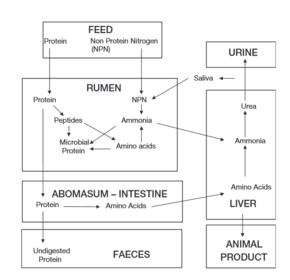
Metabolising & Digesting Fats in Cows (ruminant)
After this level, the fat will coat the dietary fibre in the digestive tract. This interferes with the digestion of fibre and decreasing the palatability of the diet.
Protected fats that escape microbial digestion in the rumen, can be used to overcome the digestive problems that are caused by high levels of rumen degradable fat.
The protected fats are readily digested and absorbed across the wall of the small intestines.
Metabolising & Digesting Water in Cows (ruminant)
Water is essential in ruminant animals. Water aids in digestion and the absorption of nutrients. The amount of water in an ruminants diet is similar to the amount of feed that is required daily. Water is absorbed in the small intestines.
Monosaccharides
What are Monosaccarides?
Monosaccharide is a term for a simple sugar. The types of simple sugars that are found in food include:
1. Glucose
2. Fructose
3. Galactose

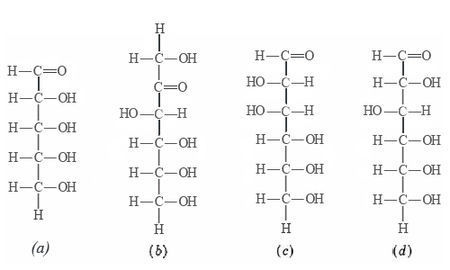
Fatty Acids
What are Fatty Acids?
A Fatty acid is a carboxylic acid with a long chain. This is either saturated or unsaturated. Fatty acids are the building blocks of fat in the body and they are produced when fats are broken down and digested in the body.
Amino Acids
What are Amino Acids?
Amino acids are a simple organic compound that contains both Carboxyl (-COOH) and an Amino (-NH2) group.
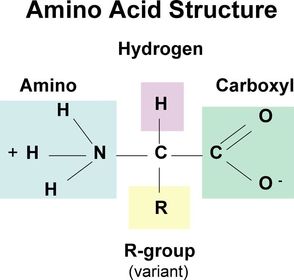
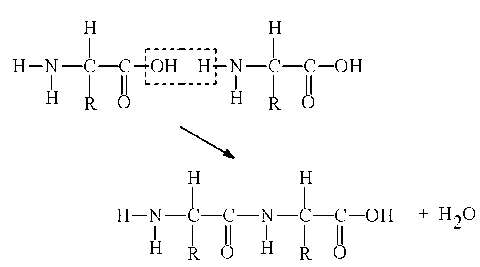
http://www.livestrong.com/article/463013-digestion-of-vitamins-minerals/
journals.cambridge.org/action/displayAbstract?fromPage=online&aid=607096&fileId=S0954422401000117
http://www.publish.csiro.au
/?act=view_file&file_id=SA0501041.pdf
http://aitc.ca/bc/uploads/ruminants.pdf
http://bizplan-uz.com/learning/course/?COURSE_ID=6&CHAPTER_ID=0110&LESSON_PATH=8.110
http://animalscience-old.tamu.edu/
beef-skillathon/nutrition_digestivesystem.html
http://www.une.edu.au/__data/assets/pdf_file/0019/72910/Ruminant-Digestive-System-and-Ruminant-Nutrition-June-2014.pdf

 Hide known cards
Hide known cards